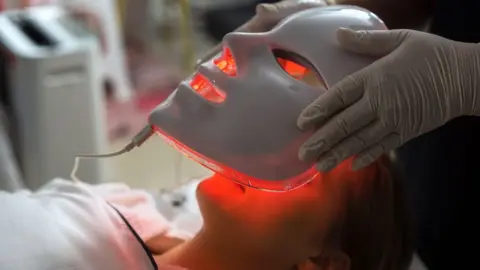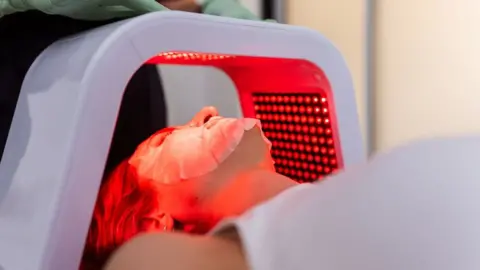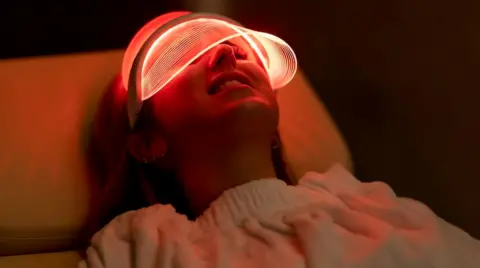Reporter of Health and Welfare
 Getty Images
Getty ImagesLED technology has been used To address a number of skin issues, such as eczema, soft to moderate acne, psoriasis and sun damage in a medical environment.
But the LED market at home is on the verge of making a mass industry – with masks and other retail equipment for everything from £ 40 to 1,500.
Technology utilizes the power of light (LED) diodes, which then stimulate skin cells when they are exposed to the skin repeatedly.
Masking developers make great claims that homemade masks at home can be used to treat acne wounds, sun damage and excellent lines – but does this remain in control?
 Getty Images
Getty ImagesThe LED market is set to apply £ 600 million globally by 2032 – which is nearly twice what will be air flow technology like Dyson Airwrap is worth the same point.
According to the dermatologist Dr. Jonathan Kentley, LED technology works by making the skin absorb the energy of light, which then causes cellular changes in a process known as Photobiomoduction (PBM).
“This allows new blood vessels and skin cells to form, along with more collagen and elastin,” he tells the BBC.
“PBM is also used to treat acne as it has anti-inflammatory effects and reduces the amount of oil on the skin,” he adds.
A Last comprehensive study E PBM stated that more clinical evidence on humans should be made to fully understand how it actually works.
The US space agency NASA first began studying the LED effect in the 1990s to see if it can help regenerate cells.
Since then, medical degree equipment has been used by dermatologists “for many years”, according to Dr. Kentley.
But the masks at home have only been in the retail market for about five years and cost some of the medical equipment.
The main differences between medical equipment and high -road masks are LED strength, the number of lamps on the equipment and how close they decrease on the surface of the skin when used.
LED therapy masks are ‘visually interesting’
Dr justine klukWhich runs its dermatology clinic and is specialized in the treatment of acne, believes that while the home mask “sounds promising”, the wholesale manufacturers are “speculating” for their benefits.
“I don’t believe anyone has run clinical evidence of the LED mask at home to see if it is the same dose as a device you will use in a clinic or hospital,” she tells the BBC.
“No one is testing these devices in quite large samples of sample for quite long periods of time for us to feel really safe.
“So I believe the benefits of using one of these masks are probably very modest,” she adds.
Skincare constitutes Nearly half of all global sales in the beauty industry – And it is decided to continue to grow more than hair likes, make-up and aroma next year.
This is being strengthened by generation Z (those who were born between 1995 and 2009) and even Generation Alpha (born 2010 so far) whose Skincare fascination is said to be Fuel from social media trends.
Dr. Clak says she noticed “people’s interest in home skin care and treatments has grown a lot since Covid” and believes that the “visually interesting” element of the LED mask makes it such an attractive product to sell online.
“People sitting watching TV wearing a red LED mask enhances people’s curiosity.
“Consultationo Other consultation I have had for the last six months has included people who ask me about LED masks,” she adds.
 Getty Images
Getty ImagesWhen looking for LED masks on social media platforms like Tiktok, you will meet hundreds of videos with users showing their results after using one of these devices at home.
Natalie O’Neill, 29, tells the BBC that she started using a “curiosity to see if I would notice any change” and did not use it to treat an existing skin condition like acne.
The creator of the skin content says: “I noticed a change in my skin after a couple of weeks and I felt it prevents real breaking.”
She adds that the mask has helped “keep my skin tone looking more” and the faded signs on her face faster.
O’Neill was not paid to promote a special mask and warns all its contents in this technology, saying it uses it along with a sustainable skin routine.
“Getting red light or LED therapy at a clinic cannot be immediately transferred to a mask that many customers do not understand – I’m fine with this because I have the right expectations,” she adds.
Part of the Appeal of LED masks is that they are easy to use and therefore have a low barrier to entry for potential buyers.
Laurence Newman is the chief executive of Rasenybody, a mask led by whose home is one of the best sellers in the world.
He began selling professional equipment in clinics more than 25 years ago and began developing an LED mask at home in 2009, extracting the company’s first device just less than 10 years later.
“We see people use it for 10 minutes and get an immediate glow afterwards,” he tells the BBC.
Newman says women in particular “are going to the skin completely non-invasive” and require ways to improve their skin without botox and fillers.
Newman says the masks that his company sells are developed using the same technology as medical equipment, which have a light wavelength of demand.
He points out that the home -led masks market and in fact the home beauty technology market are in their infancy, with the growth of “a true movement of education”.
‘That’s a lot of money to spend’
Dr. Kentley concludes that “PBM is considered largely safe, even at high levels”, so the use of any form of LED technology is unlikely to “cause damage to cells”, however more research on how it works exactly to understand what it can do.
“There have been many experimental and clinical studies in the use of PBM for various dermatological conditions, however they have changed in the device parameters and treatment protocols,” he adds.
“Many of these studies were small and unstable and often paid by manufacturers, so it is difficult to draw concrete conclusions.”
He says that if one is inclined to buy a device, they must ensure that they choose one who has EU security certifications and a high density of LED lamps in the mask to ensure that sufficient energy is being delivered to the skin.
Dr Klak also says she does not “want to discourage anyone” who is intrigued by technology, but wants them to understand that this is a lot of money to spend on a device that can potentially support a good routine for the skin, or if it is heavy like acne, a good recipe mode and some lifestyle measurements. “
